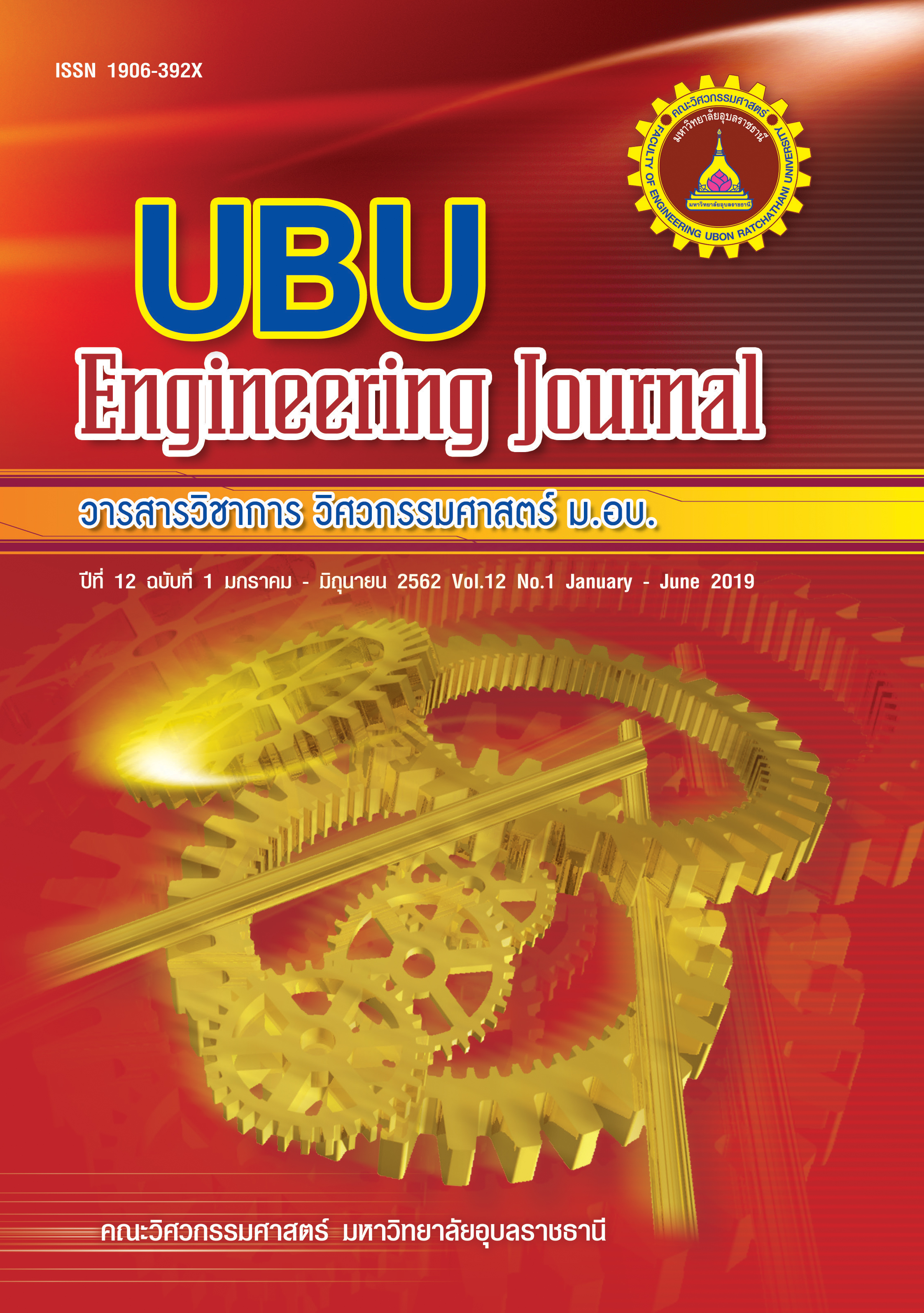Comparison of entrapped Pseudomonas fluorescens MC46 and Ochrobactrum sp. MC22 for removing triclocarban antibiotics
Main Article Content
Abstract
This research aimed to investigate triclocarban (TCC) antibiotics removal efficiency comparison between Pseudomonas fluorescens MC46 and Ochrobactrum sp. MC22. The study was performed contaminant removal by microbes in both free and entrapped cell forms. Barium alginate was chosen as an entrapment material. The experiment included TCC removal and intermediate monitoring test and structural observation of entrapped cells using scanning electron microscope. The result showed that the entrapped cells had higher TCC removal performance than the free cells (removal efficiencies of up to 53 and 38, respectively). The TCC removal efficiencies by MC46 were slight better than those by MC22. Based on the intermediate monitoring, 3,4-dichloroaniline, 4-chloroaniline, and aniline were detected. Both microbes well degraded TCC and the three intermediates. TCC was transformed to be less toxic substances. For micro-structural observation, the dense net matrix with microbial cells was found. After the application, numerous microbial cells grew in the material. The result showed that the entrapment material promoted good environment for cell growth and protected cells form toxic substances resulting high TCC removal efficiencies.
Article Details
References
[2] Heidler, J. and Halden, R.U. 2007. Mass Balance Assessment of Triclosan Removal During Conventional Sewage Treatment. Chemosphere, 66: 362-369.
[3] United States Environmental Protection Agency. 2009. Biosolids (Targeted National Sewage Sludge Survey Report).
[4] Consortium T. 2002. Iuclid Data Set. Vol. 44, TCC Consortium, New York.
[5] Halden, R.U. and Pall, D.H. 2005. Co-Occurrence of Triclocarban and Triclosan in U.S. Water Resources. Environmental science and Technology, 39: 1420-1426.
[6] Sipahutar, M.K. and Vangnai, A.S. 2017. Role of Plant Growth-promoting Ohrobactrum sp. MC22 on Triclocarban Degradation and Toxicity Mitigation to Legume Plants. Journal of Hazardous Materials, 329: 38–48.
[7] Sipahutar, M.K., Piapukiew, J. and Vangnai, A.S. 2018. Efficiency of the Formulated Plant-growth Promoting Pseudomonas fluorescens MC46 Inoculant on Triclocarban Treatment in Soil and Itseffect on Vigna radiata Growth and Soil Enzyme Activities. Journal of Hazardous Materials, 344: 883–892.
[8] Vangnai, A.S. and Petchkroh, W. 2007. Biodegradation of 4-chloroaniline by Bacteria Enriched from Soil. FEMS Microbiology Letters, 268: 209–216.
[9] Siripattanakul, S., Wirojanagud, W., McEvoy, J. and Khan, E. 2008. Effect of Cell-to-matrix Ratio in Polyvinyl Alcohol Immobilized Pure and Mixed Cultures on Atrazine Degradation. Water Air Soil Pollution, 8: 257–266.
[10] Siripattanakul, S., Pochant, C.J. and Khan, E. 2010. Nitrate Removal from Agricultural Infiltrate by Bioaugmented Free and Alginate Entrapped Cells. Water Environment Research, 82: 617–621.
[11] Siripattanakul-Ratpukdi, S. and Tongkliang, T. 2012. Municipal Wastewater Treatment Using Barium Alginate Entrapped Activated Sludge: Adjustment of Utilization Conditions. International Journal of Chemical Engineering and Applications, 3(5): 328-332.
[12] Taweetanawanit, P., Radpukdee, T., Giao, N.T. and Siripattanakul-Ratpukdi, S. 2017. Mechanical and Chemical Stabilities of Barium Alginate Gel: Influence of Chemical Concentrations. Key Engineering Materials, 718: 62-66.
[13] Mulla, S.I., Bangeppagarib, M., Mahadevanc, G.D., Eqanid, S.A.M.A.S., Sajjana, D.B., Tallure, P.N., Megadia, V.B. and Ninnekar H.Z. 2016. Biodegradation of 3-chlorobenzoate and 3-hydroxybenzoate by Polyurethane Foam Immobilized Cells of Bacillus sp. OS13. Journal of Environmental Chemical Engineering, 4: 1423-1431.
[14] Hsu, F.Y., Wang, Z.Y. and Chang, B.V. 2013. Use of Microcapsules with Electrostatically Immobilized Bacterial Cells or Enzyme Extract to Remove Nonylphenol in Wastewater Sludge. Chemosphere, 91: 745–750.
[15] Pramanik, S. and Khan, E. 2008. Effects of Cell Entrapment on Growth Rate and Metabolic Activity of Mixed Cultures in Biological Wastewater Treatment. Enzyme and Microbial Technology, 43: 245-251.
[16] Pramanik, S. and Khan, E. 2009. Effects of Cell Entrapment on Growth Rate and Metabolic Activity of Pure Cultures Commonly Found in Biological Wastewater Treatment. Biochemical Engineering Journal, 46: 286–293.
[17] Hongsawat, P. and Vangnai, A.S. 2011. Biodegradation Pathways of Chloroanilines by Acinetobacter baylyi strain GFJ2. Journal of Hazardous Materials, 186: 1300–1307.
[18] Hill, C.B. and Khan, E. 2008. A Comparative Study of Immobilized Nitrifyingand Co-Immobilized Nitrifying and Denitrifying Bacteriafor Ammonia Removal from Sludge Digester Supernatant. Water Air Soil Pollution, 195: 23–33.

